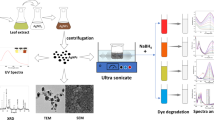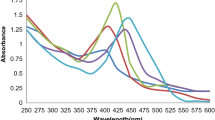Abstract
In the present study, silver and gold nanoparticles (AgNPs and AuNPs) were green synthesised using the aqueous plant extract of Stemona tuberosa Lour. When plant extract was mixed with AgNO3 and HAuCl4 solutions in separate reactions, the amalgamated solutions turned deep reddish brown and dark purple in colour after 48 h indicating the formation of AgNPs and AuNPs. UV-Visible analysis of green synthesised AgNPs and AuNPs have shown absorption maximum at 443.85 nm and 539.72 respectively after 48 h. Energy dispersive X-ray spectroscopy (EDX) analysis confirmed the presence of pure silver in the green synthesised AgNPs and pure gold in the plant-mediated AuNPs. X-ray diffractometer (XRD) data revealed the face-centred cubic nature of AgNPs. Fluorescence transmission infrared (FTIR) spectrum has shown the characteristic peaks of different phytochemicals in the plant extract which acted as stabilising or capping agents of AgNPs. Scanning electron microscopy (SEM) analysis of AgNPs and AuNPs revealed that the nanoparticles are monodispersed. Transmission electron microscopy (TEM) studies revealed that AgNPs were mostly spherical with an average size of 25 nm whereas selected area electron diffraction (SAED) analysis confirmed their crystalline nature. Both AgNPs and AuNPs of S. tuberosa Lour have shown potential catalytic activity in the presence of sodium borohydride (NaBH4) in the degradation and removal of 4-nitrophenol, methylene blue, methyl orange and methyl red.






Similar content being viewed by others
References
Ahmed S, Ahmad M, Swami BL, Ikram S (2016) A review on plants extract mediated synthesis of silver nanoparticles for antimicrobial applications: a green expertise. J Adv Res 7(1:17–28
Ajitha B, Reddy YAK, Reddy PS (2014) Biogenic nano-scale silver particles by Tephrosia purpurea leaf extract and their inborn antimicrobial activity. Spectrochim Acta Part A Mol Biomol Spectrosc 121:164–172
Ansari R, Mosayebzadeh Z, Keivani B, Mohammad-khah A (2011) Adsorption of cationic dyes from aqueous solutions using polyaniline conducting polymer as a novel adsorbent. J Adv Sci Res 2(2):27–34
Ashraf JM, Ansari MA, Khan HM, Alzohairy MA, Choi I (2016) Green synthesis of silver nanoparticles and characterization of their inhibitory effects on AGEs formation using biophysical techniques. Sci Rep 6:20414
Bharali P, Paul A, Dutta P, Gogoi G, Das AK, Baruah AM (2014) Ethnopharmacognosy of Stemona tuberosa Lour., a potential medicinal plant species of Arunachal pradesh, India. World J Pharm Pharm Sci 3(4):1072–1081
Edison TJI, Sethuraman MG (2013) Biogenic robust synthesis of silver nanoparticles using Punica granatum peel and its application as a green catalyst for the reduction of an anthropogenic pollutant 4-nitrophenol. Spectrochim Acta A Mol Biomol Spectrosc 104:262–264
Jayaseelan C, Rahuman A (2011) Acaricidal efficacy of synthesized silver nanoparticles using aqueous leaf extract of Ocimum canum against Hyalomma anatolicum anatolicum and Hyalomma marginatum isaaci (Acari: Ixodidae). Parasitol Res 111:1369–1378
Joseph S, Mathew B (2015) Microwave-assisted green synthesis of silver nanoparticles and their study on catalytic activity in the degradation of dyes. J Mol Liq 204:184–191
Jyoti K, Singh A (2016) Green synthesis of nanostructured silver particles and their catalytic application in dye degradation. J Genet Eng Biotechnol 14:2311–2317
Jyoti K, Baunthiyal M, Singh A (2016) Characterization of silver nanoparticles synthesized using Urtica dioica Linn leaves and their synergistic effects with antibiotics. J Radiat Res Appl Sci 9(3):217–227
Karthik R, Hou Y-S, Chen S-M, Elangovan A, Ganesan M, Muthukrishnan P (2016) Eco-friendly synthesis of Ag-NPs using Cerasus serrulata plant extract- its catalytic, electrochemical reduction of 4-NPh and antibacterial activity. J Ind Eng Chem 37:330–339
Khan S, Runguo W, Tahir K, Jichuan Z, Zhang L (2017) Catalytic reduction of 4-nitrophenol and photo inhibition of Pseudomonas aeruginosa using gold nanoparticles as photocatalyst. J Photochem Photobiol B Biol 170:181–187
Kharub M (2012) Use of various technologies, methods and adsorbents for the removal of dye. J Environ Res Dev 6:3A
Kjellstrom T, Lodh M, McMichael T et al (2006) Air and water pollution: burden and strategies for control. In: Jamison DT, Breman JG, Measham AR, Alleyne G, Claeson M, Evans DB, Jha P, Mills A, Musgrove P (eds) Disease control priorities in developing countries, 2nd edn. World Bank, Washington (DC), pp 817–832
Kumar TVR, Murthy JSR, Narayana Rao M, Bhargava Y (2016) Evaluation of silver nanoparticles synthetic potential of Couroupita guianensis Aubl., flower buds extract and their synergistic antibacterial activity. 3 Biotech 6(92)
Lee KD, Nagajyothi PC, Sreekanth TVM, Park S (2015) Eco-friendly synthesis of gold nanoparticles (AuNPs) using Inonotus obliquus and their antibacterial, antioxidant and cytotoxic activities. J Ind Eng Chem 26:67–72
Monali G, Jayendra K, Avinash I, Aniket G, Rai M (2009) Fungus-mediated synthesis of silver nanoparticles and their activity against pathogenic fungi in combination with fluconazole. Nanomedicine 5:382–386
Otari SV, Patil RM, Nadaf NH, Ghosh SJ, Pawar SH (2012) Green biosynthesis of silver nanoparticles from an actinobacteria Rhodococcus sp. Mater Lett 72:92–94
Padalia H, Moteriya P, Chanda S (2015) Green synthesis of silver nanoparticles from marigold flower and its synergistic antimicrobial potential. Arab J Chem 8:732–741
Patra JK, Kwon Y, Baek K (2016) Green biosynthesis of gold nanoparticles by onion peel extract: synthesis, characterization and biological activities. Adv Powder Technol 27(5):2204–2213
Pei X, Qu Y, Shen W, Li H, Zhang X, Li S, Zhang Z, Li X (2017) Green synthesis of gold nanoparticles using fungus Mariannaeasp. HJ and their catalysis in reduction of 4-nitrophenol. Environ Sci Pollut Res 24:21649–21659
Prasad C, Srinivasulu K, Venkateswarlu P (2015) Catalytic reduction of 4-nitrophenol using biogenic silver nanoparticles derived from papaya (Carica papaya) peel extract. Ind Chem 1(1):1000104
Raja S, Ramesh V, Thivaharan V (2017) Green biosynthesis of silver nanoparticles using Calliandra haematocephala leaf extract, their antibacterial activity and hydrogen peroxide sensing capability. Arab J Chem 10:253–261
Reddy NKB, Kumar HAK, Mandal BK (2016) Biofabricated silver nanoparticles as green catalyst in the degradation of different textile dyes. J Environ Chem Eng 4(1):56–64
Saha J, Begum A, Mukherjee A, Kumar S (2017) A novel green synthesis of silver nanoparticles and their catalytic action in reduction of methylene blue dye. Sustain Environ Res 27:245–250
Sandeep S, Santhosh SA, Kumara Swamy N, Suresh SG, Melo SJ, Mallu P (2016) Biosynthesis of silver nanoparticles using Convolvulus pluricaulis leaf extract and assessment of their catalytic, electrocatalytic and phenol remediation properties. Adv Mater Lett 7(5):383–389
Shah K (2014) Biodegradation of azo dye compounds. Int Research J of Biochem and Biotech 1(2):005–013
Shanmugam C, Sivasubramanian G, Parthasarathi B, Baskaran K, Balachander R, Parameswaran VR (2016) Antimicrobial, free radical scavenging activities and catalytic oxidation of benzyl alcohol by nano-silver synthesized from the leaf extract of Aristolochia indica L: a promenade towards sustainability. Appl Nanosci 6:711–723
Singh S, Bharti A, Meena VK (2014) Structural, thermal, zeta potential and electrical properties of disaccharide reduced silver nanoparticles. J Mater Sci Mater Electron 25:3747–3752
Singh P, Singh H, Ju Kim Y, Mathiyalagan R, Wang C, Yang DC (2016) Extracellular synthesis of silver and gold nanoparticles by Sporosarcina koreensis DC4 and their biological applications. Enzym Microb Technol 86:75–83
Sinha T, Ahmaruzzaman M (2015) High-value utilization of egg shell to synthesize silver and gold–silver core shell nanoparticles and their application for the degradation of hazardous dyes from aqueous phase-a green approach. J Colloid Interface Sci 453:115–131
Sudha M, Saranya A, Selvakumar G, Sivakumar N (2014) Microbial degradation of azo dyes: a review. Int J Curr Microbiol App Sci 3(2):670–690
Supraja N, Prasad TNVKV, David E, Krishna TG (2016) Antimicrobial kinetics of Alstonia scholaris bark extract-mediated AgNPs. Appl Nanosci 6:779–787
Suresh G, Gunasekar PH, Kokila D, Prabhu D, Dinesh D, Ravichandran N, Ramesh B, Koodalingam A, Siva GV (2014) Green synthesis of silver nanoparticles using Delphinium denudatum root extract exhibits antibacterial and mosquito larvicidal activities. Spectrochim Acta Part A Mol Biomol Spectrosc 127:61–66
Suvith VS, Philip D (2014) Catalytic degradation of methylene blue using biosynthesized gold and silver nanoparticles. Spectrochim Acta A Mol Biomol Spectrosc 118:526–532
Swamy MK, Akhtar MS, Mohanty SK, Uma Rani S (2015) Synthesis and characterization of silver nanoparticles using fruit extract of Momordica cymbalaria and assessment of their in vitro antimicrobial, antioxidant and cytotoxicity activities. Spectrochim Acta A Mol Biomol Spectrosc 151:939–944
Syed A, Saraswati S, Kundu GC, Ahmad A (2013) Biological synthesis of silver nanoparticles using the fungus Humicola sp. and evaluation of their cytoxicity using normal and cancer cell lines. Spectrochim Acta Part A Mol Biomol Spectrosc 114:144–147
Tahir K, Nazir S, Li B, Ullah Khan A, UlHaq Khan Z, Yu Gong P, Ullah Khan S, Ahmad A (2015) Nerium oleander leaves extract mediated synthesis of gold nano- particles and its antioxidant activity. Mater Lett 156:198–201
Ul Haq Khan Z, Khan A, Chen Y, Khan A, Shah N, Muhammad N, Murtaza B, Tahir K (2017) Photo catalytic applications of gold nanoparticles synthesized by green route and electrochemical degradation of phenolic Azo dyes using AuNPs/GC as modified paste electrode. J Alloys Compd 725:869–876
Varadavenkatesan T, Selvaraj R, Vinayagam R (2016) Phyto-synthesis of silver nanoparticles from Mussaenda erythrophylla leaf extract and their application in catalytic degradation of methyl orange dye. J Mol Liq 221:1063–1070
Vidhu VK, Philip D (2014) Catalytic degradation of organic dyes using biosynthesized silver nanoparticles. Micron 56:54–62
Acknowledgments
The authors are thankful to the University Grants Commission (UGC) RGNF’s, Govt. of India, for providing financial support and the Department of Physics, Acharya Nagarjuna University, Guntur, for providing research facilities.
Author information
Authors and Affiliations
Corresponding author
Ethics declarations
Conflict of interest
The authors declare that there is no conflict of interest.
Additional information
Responsible editor: Philippe Garrigues
Rights and permissions
About this article
Cite this article
Bonigala, B., Kasukurthi, B., Konduri, V.V. et al. Green synthesis of silver and gold nanoparticles using Stemona tuberosa Lour and screening for their catalytic activity in the degradation of toxic chemicals. Environ Sci Pollut Res 25, 32540–32548 (2018). https://doi.org/10.1007/s11356-018-3105-9
Received:
Accepted:
Published:
Issue Date:
DOI: https://doi.org/10.1007/s11356-018-3105-9




